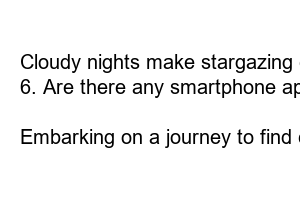별자리 찾는법
Title: How to Find Constellations: A Beginner’s Guide to Stargazing
Introduction:
Do you ever find yourself gazing up at the night sky, wondering about the twinkling stars and the stories they hold? Stargazing can be a fascinating and fulfilling hobby, allowing us to connect with the vastness of the universe. And what better way to start than by learning to find constellations? In this blog post, we will guide you through the process of locating constellations, enabling you to embark on a mesmerizing celestial journey each time you look up.
1. Understand the Basics of Constellations:
Constellations are groups of stars that form recognizable patterns in the night sky. Familiarizing yourself with the major constellations and their shapes is essential for successful stargazing. *Orion’s Belt*, for instance, is a famous constellation consisting of three bright stars lined up horizontally.
2. Use Stellar Apps and Websites:
Thanks to technology, uncovering the secrets of the night sky has become easier than ever. Various smartphone apps and websites offer real-time maps, making it simple to identify and locate constellations with just a few taps. Explore options like *SkyView*, *Star Walk*, or *Stellarium* to enhance your stargazing experience.
3. **Let the Moon Guide You:**
The moon can be a helpful guide when seeking out constellations. Its position and brightness can affect visibility, so check lunar phase calendars to identify nights with less moonlight. New moon or crescent moon phases provide darker skies, making it easier to spot constellations.
4. **Find the Dark Spots:**
One of the biggest challenges for successful stargazing is light pollution. To avoid this, head to areas away from city lights, such as parks, fields, or mountains. These dark spots offer a clearer view and improve your chances of spotting constellations and other celestial wonders.
5. Use Star Charts and Star Guides:
Star charts and star guides are invaluable resources for navigating the night sky. These handy tools provide detailed maps and information about constellations’ positions, helping you to identify and track them. Consult books like *”The Backyard Astronomer’s Guide”* or use online resources like *Sky & Telescope* magazine.
6. **Utilize Binoculars or a Telescope:**
While constellations can often be seen with the naked eye, using binoculars or a telescope can enhance your experience. They allow you to observe fainter stars and detail within the constellations, offering a more immersive and awe-inspiring journey through the cosmos.
Frequently Asked Questions (FAQs):
1. Can I see constellations all year round?
Yes, different constellations become visible depending on the season and time of night. *Ursa Major*, commonly known as the Big Dipper, is visible from the Northern Hemisphere throughout the year, while *Orion* is prominent during winter evenings.
2. Do constellations change over time?
While the positions of constellations remain relatively fixed over centuries, they do appear to move due to Earth’s rotation. This movement is not noticeable in a human lifespan but can be observed over thousands of years.
3. How long does it take to learn constellations?
Becoming familiar with constellations can take time, but with practice, you will gradually recognize their unique shapes and patterns. Consistent stargazing and reference to star guides will quicken your learning process.
4. Can I see constellations from anywhere on Earth?
Yes, constellations are visible from all points on Earth, but the specific ones you can see depend on your latitude and the time of night. The Northern and Southern Hemispheres offer distinct arrays of constellations.
5. Can I find constellations during cloudy nights?
Cloudy nights make stargazing challenging, as clouds obstruct visibility. However, you can still observe constellations on partially cloudy nights or when the clouds periodically clear.
6. Are there any smartphone apps specifically for finding constellations?
Yes, numerous smartphone apps, such as *Star Chart*, *Night Sky*, and *Star Rover*, are designed specifically for locating and identifying constellations. These apps use your device’s compass and GPS to provide an accurate representation of the night sky.
Summary:
Embarking on a journey to find constellations can be an enchanting experience. By understanding the basics, utilizing modern tools, finding dark spots, and being patient, you can enrich your stargazing adventures. Remember to explore at different times of the year, learn from star guides, and, most importantly, marvel at the wonders of the cosmos above. Happy stargazing!

